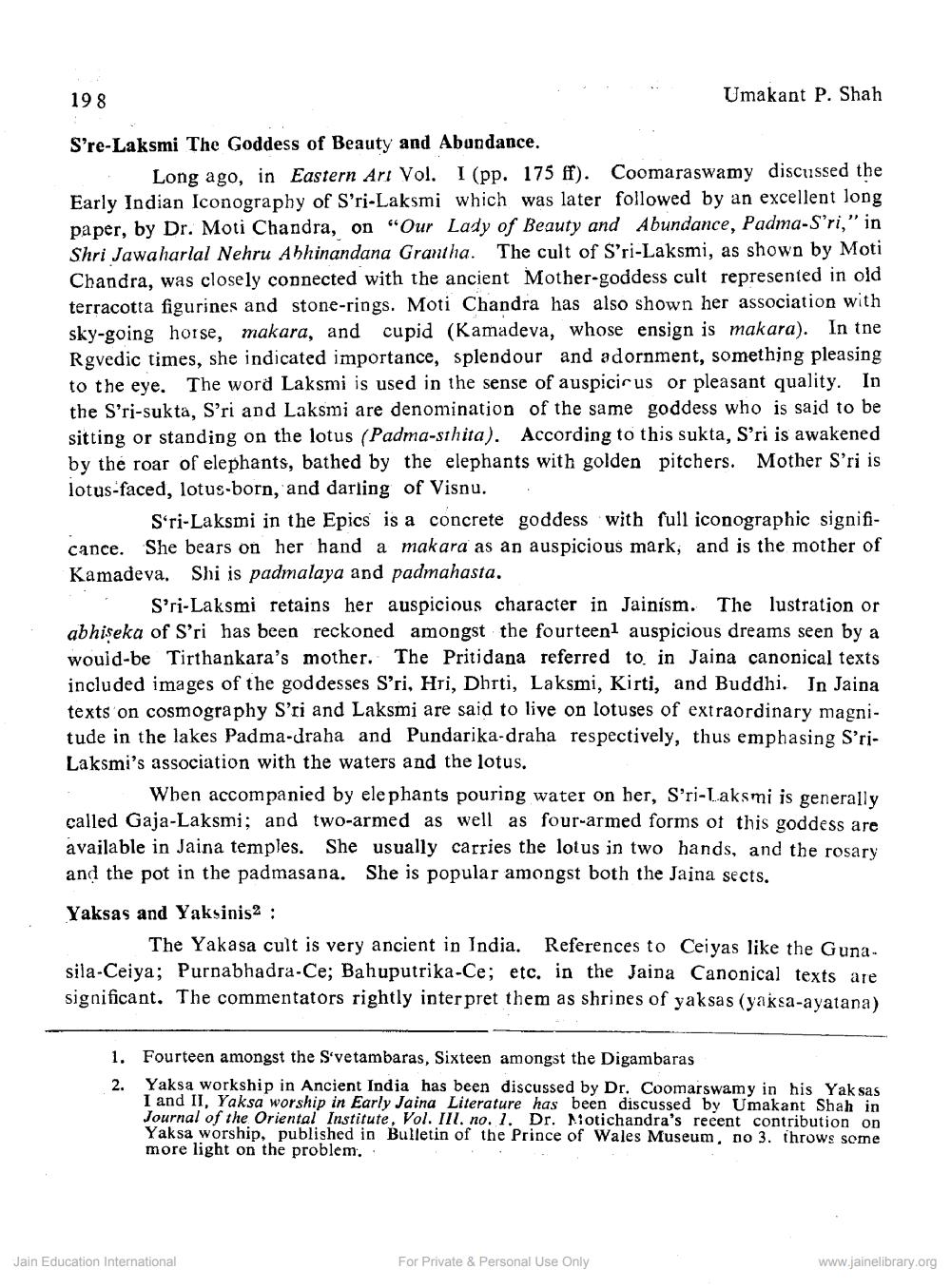________________
198
Umakant P. Shah
S're-Laksmi The Goddess of Beauty and Abundance.
Long ago, in Eastern Arı Vol. I (pp. 175 ff). Coomaraswamy discussed the Early Indian Iconography of S'ri-Laksmi which was later followed by an excellent long paper, by Dr. Moti Chandra, on “Our Lady of Beauty and Abundance, Padma-S'ri," in Shri Jawaharlal Nehru Abhinandana Grantha. The cult of S'ri-Laksmi, as shown by Moti Chandra, was closely connected with the ancient Mother-goddess cult represented in old terracotta figurines and stone-rings. Moti Chandra has also shown her association with sky-going horse, makara, and cupid (Kamadeva, whose ensign is makara). In tne Rgvedic times, she indicated importance, splendour and adornment, something pleasing to the eye. The word Laksmi is used in the sense of auspicir us or pleasant quality. In the Sri-sukta, S'ri and Laksmi are denomination of the same goddess who is said to be sitting or standing on the lotus (Padma-sthita). According to this sukta, Sri is awakened by the roar of elephants, bathed by the elephants with golden pitchers. Mother S'ri is lotus-faced, lotus-born, and darling of Visnu.
Síri-Laksmi in the Epics is a concrete goddess with full iconographic significance. She bears on her hand a makara as an auspicious mark, and is the mother of Kamadeva. Shi is padmalaya and padmahasta.
S'ri-Laksmi retains her auspicious character in Jainism. The lustration or abhiseka of S'ri has been reckoned amongst the fourteeni auspicious dreams seen by a would-be Tirthankara's mother. The Pritidana referred to in Jaina canonical texts included images of the goddesses S'ri, Hri, Dhrti, Laksmi, Kirti, and Buddhi. In Jaina texts on cosmography S'ri and Laksmi are said to live on totuses of extraordinary magnitude in the lakes Padma-draha and Pundarika-draha respectively, thus emphasing S’riLaksmi's association with the waters and the lotus.
When accompanied by elephants pouring water on her, S'ri-Laksmi is generally called Gaja-Laksmi; and two-armed as well as four-armed forms of this goddess are available in Jaina temples. She usually carries the lotus in two hands, and the rosary and the pot in the padmasana. She is popular amongst both the Jaina sects.
Yaksas and Yaksinis2 :
The Yakasa cult is very ancient in India. References to Ceiyas like the Guna. sila-Ceiya; Purnabhadra-Ce; Bahuputrika-Ce; etc. in the Jaina Canonical texts are significant. The commentators rightly interpret them as shrines of yaksas (yaksa-ayatana)
1. Fourteen amongst the S'vetambaras, Sixteen amongst the Digambaras 2. Yaksa workship in Ancient India has been discussed by Dr. Coomarswamy in his Yaksas
I and II, Yaksa worship in Early Jaina Literature has been discussed by Umakant Shah in Journal of the Oriental Institute, Vol. M. no. 1. Dr. Miotichandra's recent contribution on Yaksa worship, published in Bulletin of the Prince of Wales Museum, no 3. throws some more light on the problem,
Jain Education International
For Private & Personal Use Only
www.jainelibrary.org




